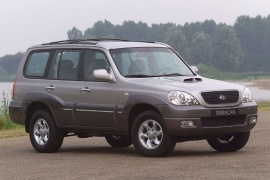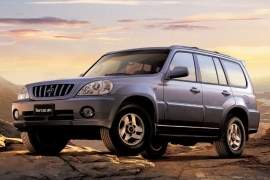HYUNDAI Terracan Models/Series Timeline, Specifications & Photos
First production year: 2001
Engines: Gasoline, Diesel
Body style: SUV (Sports Utility Vehicle)
In 2002, Hyundai introduced the Terracan as a replacement for the Galloper range based on the first generation of the Mitsubishi Pajero/Montero.
With little knowledge about developing a 4x4 vehicle from the ground up, Hyundai considered it could strip to the chassis a Galloper and give it a new bodywork. Also, it replaced the engines and improved its transmissions, but basically, it was more or less a refreshed Pajero/Montero. Fortunately, that chassis was excellent for its times and continued to be very good even after two decades.
The Korean designers tried to hide the Japanese model's links by introducing smoother lines and softened edges. Along with the facelift, the Terracan received rectangular fog-lights instead of the round ones offered before. In the back, Hyundai introduced a new design for the taillights.
Inside, the Terracan was already recognized as a spacious vehicle, mostly for four passengers. Three people could have to feel cramped in the back due to the transmission tunnel and car's interior width; a small tribute paid for the old chassis. Its huge trunk was easy to access from behind via a wide liftgate or inside the car, thanks to the 60/40 split-folding rear bench. Depending on the trim level and options, the steering wheel received a few buttons for the audio system. The carmaker worked hard to integrate a stereo-cassette and CD-player on the center stack, replacing the older stereo's aftermarket-look.
Under the hood, Hyundai offered a choice of two engines: a 3.5-liter gasoline V-6 and a 2.9-liter turbo-diesel. Both were paired to a 4x4 system and a high-low range for the transfer case.
Hyundai expanded its range when it introduced the Galloper in 1991 and, after ten years, it unveiled the Terracan as a successor.
The Korean carmaker evolved with massive help from Mitsubishi, which provided engines, drivetrains, gearboxes, and even entire vehicles sold as re-badged by Hyundais. The Galloper was a second-generation Pajero/Montero/Shogun, and the Terracan used the same chassis. But Hyundai didn't have enough experience building a new bodywork from scratch, so it just changed a little here and there.
Since it was a body-on-frame vehicle, Hyundai could have made the Terracan look like anything, but they chose not to. They followed the same lines of the Pajero/Montero/Shogun but with softer edges and new plastic molds on the sides. Its tear-shaped headlights and the seven-slat grille were new, but it was easy to guess its ancestor. Unlike the Galloper, Hyundai offered the Terracan as a five-door vehicle only.
Hyundai's designers tried to make a significant change on the interior, where they arranged an upmarket cabin, at least for the top trim level. The base version featured cloth seats, power windows, locks and mirrors, and an AC unit, plus a decent stereo on the center stack. The full-options models added leather seats, sunroof, and wood veneers everywhere.
Under the hood, Hyundai installed a choice of engines depending on the market. The European and Australian customers received a 2.9-liter turbodiesel, while other countries got the 3.5-liter gasoline V-6 or even a 2.4-liter inline-four.

